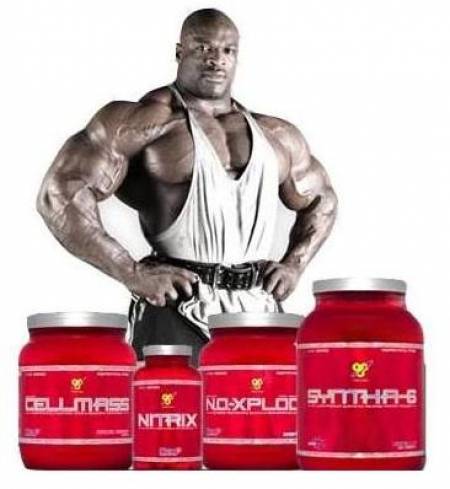Betaine aka TMG
 Another new supplement hyped by the supplement industry. Everybody that saw the documentary “Bigger - Stronger – Faster” knows that this industry sells dreams. But most guys fall for the nice adds, the science backed “evidence” and the pictures of athletes pumped up by anabolic steroids (…and a lot of other “illegal means” ) that REALLY work wonders on your appearance, telling you this supplement is responsible for their gains.
Another new supplement hyped by the supplement industry. Everybody that saw the documentary “Bigger - Stronger – Faster” knows that this industry sells dreams. But most guys fall for the nice adds, the science backed “evidence” and the pictures of athletes pumped up by anabolic steroids (…and a lot of other “illegal means” ) that REALLY work wonders on your appearance, telling you this supplement is responsible for their gains.
Does this mean ALL supplements and ergogenic means are worthless? Nope ..we all know by now that Creatine has a (modest) effect. And many athletes use it also while on a juice stack. You also know that most of us use silymarin (Milk thistle) to protect our liver. We use whey proteins, because they are much more comfortable to use then chickenbreasts. It’s just that you should put it in perspective and realize that all those supplement companies want to sell you their products. Most magazines just exist because supplement-companies pay a lot of money for advertisements. In the gym the gym-owner sells you these supplements or a whey shake after you are finished training. And we, writers of articles on bodybuilding, often work for supplement companies, that also run magazines, websites and web-shops. Naps doesn’t. So my unbiased opinion.
We bodybuilders know that quick sugar after a work-out is beneficial, thus banana's – chocolatemilk and also TMG will do. In this light look at these studies.
 Fact is that most studies we take seriously are funded by the industry.
Fact is that most studies we take seriously are funded by the industry.
By example:
“Impact of cocoa flavanol consumption on blood pressure responsiveness to exercise,” Berry NM, Davison K, et al, Br J Nutr, 2010 Jan 19; 1-5
The research was paid by Mars Inc.
Still it’s very interesting for us especially the outcomes of the BP while deadlifting – squatting etc.
The same goes for this study:
Karp JR, Johnston JD, Tecklenburg S, Mickleborough TD, Fly AD, Stager JM. Chocolate milk as a post-exercise recovery aid. Int. J. Sport Nut. Exerc. Metab. 2006, 16(1):78-91.
The studies were supported by a grant from the National Dairy Council and National Fluid Milk Processor Promotion Board.
While the studies were small, there's no reason not to reach for fat-free chocolate milk after your next workout, says sports nutritionist Nancy Clark, MS, RD, of Healthworks Fitness Center in Chestnut Hill, Mass.
"Athletes can consider it an inexpensive nutritional alternative to engineered sports beverages for help with post-workout recovery," she says.
The text from a supplement company:
- Lowering Homocysteine Levels
- Increasing Levels of Carnitine
- Supports Healthy Liver Function
Betaine Anhydrous is a derivative of choline and is an important nutrient which assists with various chemical processes in the body via the carrying and donation of methyl molecules throughout the system. It is also known as trimethylglycine, or TMG for short.
The name Betaine Anhydrous is derived from sugar beets, the vegetable in which it was first identified. Its availability is not limited to sugar beets though, as it can be found in many different dietary sources including but not limited to, beans and legumes, grains present in breakfast cereals, wine, seafoods, and leafy green vegetables.
Homocysteine, an amino acid which can be found in the blood, is currently being investigated by scientists as a potential source of cardiovascular issues. It is unknown as to whether or not this acid can directly cause cardiovascular problems or whether it is merely one more risk factor, but there is a correlation between high levels of homocysteine and cardiovascular problems. Betaine anhydrous is known for being able to regulate levels of homocysteine present in the blood and keep them lower regardless of whether it is a direct cause or not. Other than this, betaine anhydrous also assists in the production of carnitine, which assists in the protection of the kidneys.
Anyone that has high levels of homocysteine in their blood stream is a perfect candidate for trying out a betaine anhydrous supplement. It helps regulate the levels of this potentially harmful acid and keep them down low. It also helps keep the intestinal system fully functional and assists in the production of new cells.
Because betaine anhydrous also has the effect of increasing levels of carnitine, this means that it is perfect for those interested in physical fitness since it is the chemical carnitine which allows fat to be burned more efficiently and have more if it harvested for energy to keep the body well fueled.
Therefore, anyone interested in gaining muscle mass while also keeping their general levels of fitness up should take this supplement in conjunction with Creatine Ethyl Ester Malate, Creatine Monohydrate, or Creatine Ethyl Ester.
To put it again as I said in the right perspective:
Because betaine is a byproduct from sugar refining, the giant sugar company Danisco is financing studies on positive health effects of betaine, in the hope of finding new markets. These have shown for example that a daily 2.5 g betaine has a very small ergogenic effect.
A study performed by an independent Brazilian team concluded: “Furthermore, we showed that betaine supplementation combined or not with creatine supplementation does not affect strength and power performance in untrained subjects.” This is in complete contradiction with the text in the advertisement
Natural betaine products from DuPont are also used in personal care products for skin, hair and oral care. Betaine is also used as animal nutrition for pigs and poultry.
Factory farms supplement fodder with TMG and lysine to increase livestock’s' muscle mass and, therefore, "carcass yield" ( the amount of usable meat).
TMG supplementation decreases the amount of adipose tissue in pigs; however, research in human subjects has shown no effect on body weight, body composition, or resting energy expenditure, but only on muscle strength (2,5 gr/day).
Schwab et al 2002, "Betaine supplementation decreases plasma homocysteine concentrations but does not affect body weight, body composition, or resting energy expenditure in human subjects".
- Login to post comments


